World-class venue: many new models
Page 37
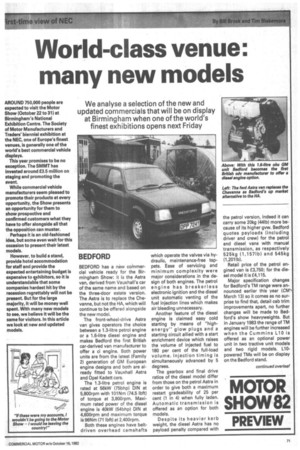
Page 38
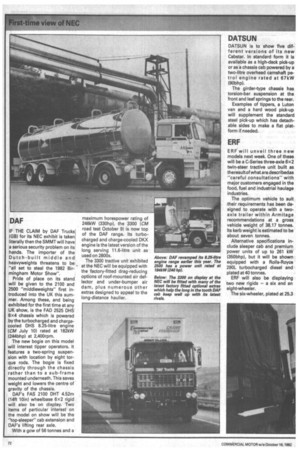
Page 39
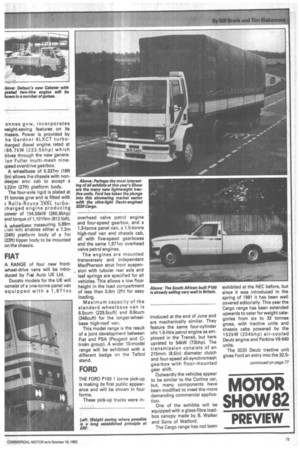
Page 41
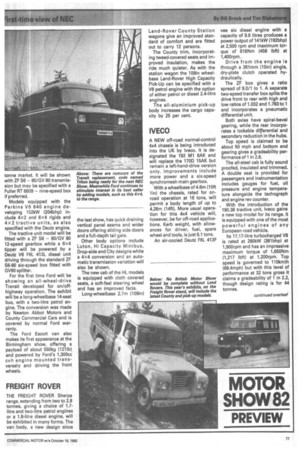
Page 42
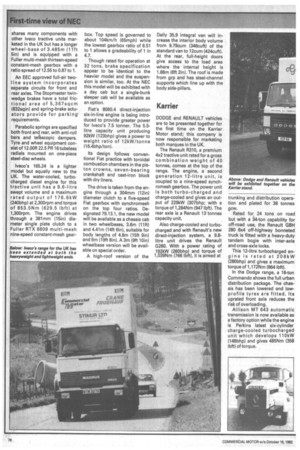
Page 43
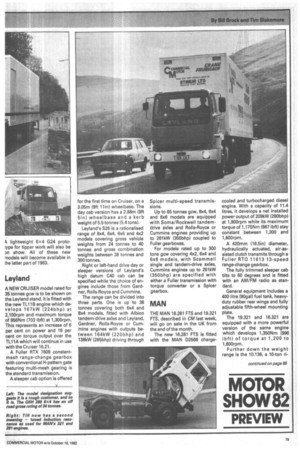
Page 45

Page 46
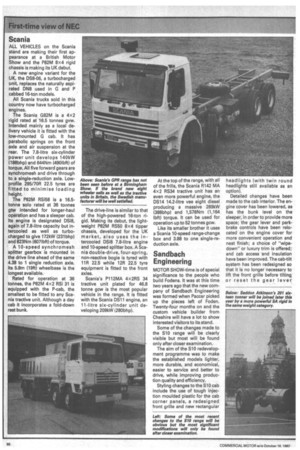
Page 47

Page 48
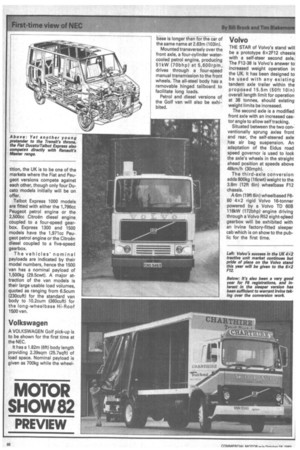
If you've noticed an error in this article please click here to report it so we can fix it.
We analyse a selection of the new and updated commercials that will be on display at Birmingham when one of the world's finest exhibitions opens next Friday
AROUND 750,000 people are expected to visit the Motor Show (October 22 to 31) at Birmingham's National Exhibition Centre. The Society of Motor Manufacturers and Traders' biennial exhibition at the NEC, one of Europe's finest venues, is generally one of the world's best commercial vehicle displays.
This year promises to be no exception. The SMMT has invested around £3.5 million on staging and promoting the event.
While commercial vehicle manufacturers seem pleased to promote their products at every opportunity, the Show presents an opportunity for them to show prospective and confirmed customers what they have to offer alongside all that the opposition can muster.
Perhaps it is an old-fashioned idea, but some even wait for this occasion to present their latest models.
However, to build a stand, provide hotel accommodation for staff and provide the expected entertaining budget is expensive to exhibitors, so it is understandable that some companies hardest hit by the recession regrettably will not be present. But for the large majority, it will be money well spent. With many new models to see, we believe it will be the same for visitors. In this article we look at new and updated models.
BEDFORD
BEDFORD has a new conimercial vehicle ready for the Birmingham Show: it is the Astra van, derived from Vauxhall's car of the same name and based on the three-door estate version. The Astra is to replace the Cheyenne, but not the HA, which will continue to be offered alongside the new model.
The front-wheel-drive Astra van gives operators the choice between a 1.3-litre petrol engine or a 1.6-litre diesel engine and makes Bedford the first British car-derived van manufacturer to offer a ci engine. Both power units are from the latest (Family 2) generation of GM European engine designs and both are already fitted to Vauxhall Astra and Opel Kadett cars.
The 1.3-litre petrol engine is rated at 56kW (75bhp) DIN at 5,800rpm with 101Nm (74.5 lbft) of torque at 3,800rpm. Maximum rated power of the diesel engine is 40kW (54bhp) DIN at 4,600rpm and maximum torque is 96Nm (71 lbft) at 2,400rpm.
Both these engines have beltdriven overhead camshafts which operate the valves via hydraulic, maintenance-free tappets. Ease of servicing and minimum complexity were major considerations in the design of both engines. The petrol engine has breakerless electronic ignition and the diesel unit automatic venting of the fuel injection lines which makes air bleeding unnecessary.
Another feature of the diesel engine is claimed easy cold starting by means of "highenergy" glow plugs and a starting circuit allied with a start enrichment device which raises the volume of injected fuel to 180 per cent of the full-load volume. Injection timing is simultaneously advanced by 5 degrees.
The gearbox and final drive ratios of the diesel model differ from those on the petrol Astra in order to give both a maximum restart gradeability of 25 per cent (1 in 4) when fully laden. Automatic transmission is offered as an option for both models.
Despite its heavier kerb weight, the diesel Astra has no payload penalty compared with the petrol version, indeed it can carry some 20kg (441b) more because of its higher gvw. Bedford quotes payloads (including driver and crew) for the petrol and diesel vans with manual transmission, as respectively 525kg (1,1 571b) and 545kg (1,2011b).
Retail price of the petrol engined van is £3,750; for the diesel model it is £4,115.
Major specification changes for Bedford's TM range were announced earlier this year (CM' March 13) so it comes as no surprise to find that, detail cab trim improvements apart, no further changes will be made to Bedford's show heavyweights. But in January 1983 the range of TM engines will be further increased when the Cummins L10 is offered as an optional power unit in two tractive unit models and two rigid models. L10powered TMs will be on display on the Bedford stand.
DAF
IF THE CLAIM by DAF Trucks1 (GB) for its NEC exhibit is takeni
literally then the SMMT will have a serious security problem on its hands. The importer of the Dutch-built middle and heavyweights threatens to be'. "all set to steal the 1982 Birmingham Motor Show".
Pride of place on its stand will be given to the 2100 and 2500 "rniddleweights" first in troduced into the UK this summer. Among these, and being exhibited for the first time at any UK show, is the FAD 2525 Di-IS 8x4 chassis which is powered
by the turbocharged and chargecooled DHS 8.25-litre engine (CM July 10) rated at 182kW (244bhp) at 2,400rpm.
The new bogie on this model will interest tipper operators. It features a two-spring suspen sion with location by eight tor que rods. The bogie is fixed directly through the chassis rather than to a sub-frame mounted underneath. This saves weight and lowers the centre of gravity of the chassis.
DAF's FAS 2100 DHT 4.52m (14ft 10in) wheelbase 6x2 rigid will also be on display. Two items of particular interest on the model on show will be the "top-sleeper" cab extension and DAF's lifting rear axle.
With a gcw of 56 tonnes and a
maximum horespower rating of 246kW (330hp), the 3300 (CM road test October 9) is now top of the DAF range.. Its turbocharged and charge-cooled DKX engine is the latest version of the long serving 11.6-litre unit as used on 2800s.
The 3300 tractive unit exhibited at the NEC will be equipped with the factory-fitted drag-reducing options of roof-mounted air deflector and under-bumper air dam, plus numerous other extras designed to appeal to the long-distance haulier.
DATSUN
DATSUN is to show five different versions of its new Cabstar. In standard form it is available as a high-deck pick-up or as a chassis cab powered by a two-litre overhead camshaft petrol engine rated at 67kW (90bhp).
The girder-type chassis has torsion-bar suspension at the front and leaf springs to the rear.
Examples of tippers, a Luton van and a hard wood pick-up will supplement the standard steel pick-up which has detachable sides to make a flat platform if needed.
ERF
ERF will unveil three new models next week. One of these will be a C-Series three-axle 6x2 twin-steer tractive unit built as the result of what are describedas "careful consultations" with major customers engaged in the food, fuel and industrial haulage industries.
The optimum vehicle to suit their requirements has been de signed to operate with a two axle trailer within Armitage recommendations at a gross vehicle weight of 38.17 tonnes. Its kerb weight is estimated to be about seven tonnes.
Alternative specifications include sleeper cab and premium
power units of up to 261 kW (350bhp), but it will be shown equipped with a Rolls-Royce 290L turbocharged diesel and plated at 40 tonnes.
ERF will also be displaying two new rigids — a six and an eight-wheeler.
The six-wheeler, plated at 25.3 onnes gvvv, incorporates veight-saving features on its ;hassis. Power is provided by he Gardner 6LXCT turbo:harged diesel engine rated at I 66.7kW (223.5bhp) which irives through the new generaion Fuller multi-mesh nine;peed overdrive gearbox.
A wheelbase of 5.337m (18ft 2in) allows the chassis with nonilleeper smc cab to accept a 3.22m (27ft) platform body.
The four-axle rigid is plated at 31 tonnes gvw and is fitted with
Rolls-Royce-2-6-51 turbo:harged engine producing power of 194.56kW (260.8bhp) and torque of 1,101Nm (812 Ibft). A wheelbase measuring 5.89m ivrt 4 ini enables either a 7.3m (24ft) platform body of a 7m (23ft) tipper body to be mounted on the chassis.
FIAT
A RANGE of four new frontwheel-drive vans will be introduced by Fiat Auto UK Ltd.
Ducato models for the UK will consist of a one-tonne panel van equipped with a 1,971cc overhead valve petrol engine and four-speed gearbox, and a 1.3-tonne panel van, a 1.5-tonne high-roof van and chassis cab, all with five-speed gearboxes and the same 1,971cc overhead valve petrol engines.
The engines are mounted transversely and independent MacPherson strut front suspension with tubular rear axle and leaf springs are specified for all vehicles. This allows a low floor height in the load compartment of less than 0.6m (2ft) for easy loading.
Maximum capacity of the standard wheelbase van is 6.5cum (229.5cuft) and 9.8cum (346cuft) for the longer-wheelbase high-roof van.
This model range is the result of a joint development between Fiat and PSA (Peugeot and Citroen group). A wider 10-model range will be exhibited with a different badge on the Talbot stand.
FORD
THE FORD P100 1 tonne pick-up is making its first public appearance and will be shown in four forms.
These pick-up trucks were in troduced at the end of June and are mechanically similar. They feature the same four-cylinder ohc 1.6-litre petrol engine as employed in the Transit, but here uprated to 54kW (73bhp). The transmission consists of an 215mm (8.51n) diameter clutch and four-speed all-synchromesh gearbox with floor-mounted gear shift.
Outwardly the vehicles appear to be similar to the Cortina car, but, many components have been modified to meet the more demanding commercial application.
One of the exhibits will be equipped with a glass-fibre loadbox canopy made by B. Walker and Sons of Watford.
The Cargo range has not been exhibited at the NEC before, but since it was introduced in the spring of 1981 it has been well covered editorially. This year the Cargo range has been extended upwards to cater for weight categories from six to 32 tonnes gross, with tractive units and chassis cabs powered by the 152kW (204bhp) air-cooled Deutz engine and Perkins V8 640 units.
The 3220 Deutz tractive unit gives Ford an entry into the 32.5 tonne market. It will be shown with ZF S6 — 80/GV 80 transmission but may be specified with a Fuller RT 6609 — nine-speed box if preferred.
Models equipped with the Perkins V8 640 engine developing 152kW (204bhp) include 4x2 and 6x4 rigids and 4x2 tractive units, as also specified with the Deutz engine.
The tractive unit model will be fitted with a ZF S6 — 80/GV 80 12-speed gearbox while a 6x4 tipper will be powered by a Deutz V6 F6L 413L diesel unit driving through the standard ZF S6-80 six-speed box fitted with GV80 splitter.
For the first time Ford will be showing an all-wheel-drive Transit developed for on/offhighway operation. The exhibit will be a long-wheelbase 14-seat bus, with a two-litre petrol engine. The conversion was made by Newton Abbot Motors and County Commercial Cars and is covered by normal Ford warranty.
The Ford Escort van also makes its first appearance at the Birmingham show, offering a payload of about 550kg (1211b) and powered by Ford's 1,300cc cvh engine mounted transversely and driving the front wheels.
FREIGHT ROVER
THE FREIGHT ROVER Sherpa range, extending from two to 2.8 tonnes, giving a choice of 1.7litre and two-litre petrol engines or a 1.8-litre diesel engine, will be exhibited in many forms. The van body, a new design since the last show, has quick draining vertical panel seams and wider doors offering sliding side doors and a full-depth tail gate.
Other body options include Luton, Hi Capacity Minibus, Drop-side and City designs while a 4x4 conversion and an automatic transmission variation will also be shown.
The new cab of the HL models is equipped with cloth covered seats, a soft-feel steering wheel and has an improved facia.
Long-wheelbase 2.7m (1091n) Land-Rover County Station wagons give an improved standard of comfort and are fitted out to carry 12 persons.
The County trim, incorporating tweed-covered seats and improved insulation, makes the ride much quieter. As with the station wagon the 109in wheelbase Land-Rover High Capacity Pick-Up can be specified with a V8 petrol engine with the option of either petrol or diesel 2.4-litre engines.
The all-aluminium pick-up body increases the cargo capacity by 25 per cent.
IVECO
A NEW off-road normal-control 4x4 chassis is being introduced into the UK by lveco. It is designated the 192 M1 6AK and will replace the 170D 15AK but remain a left-hand-drive version only. Improvements include more power and a six-speed synchromesh main gearbox.
With a wheelbase of 4.6m (15ft 1in) the chassis, rated for onroad operation at 16 tons, will permit a body length of up to 4.26m (14ft). More usual operation for this 4x4 vehicle will, however, be for off-road applications. Kerb weight, with allowances for driver, fuel, spare wheel and tools, is just 6.1 tons.
An air-cooled Deutz F6L 413F
vee six diesel engine with a capacity of 9.6 litres produces a power output of 141kW (192bhp) at 2,500 rpm and maximum torque of 618Nm (458 Ibft) at 1,40Orpm.
Drive from the engine is through a 381mm (15in) single, dry-plate clutch operated hydraulically.
The ZF box gives a ratio spread of 9.0/1 to 1. A separate two-speed transfer box splits the drive front to rear with high and low ratios of 1.032 and 1.783 to 1 and incorporates a pneumatic differential unit.
Both axles have spiral-bevel gearing, while the rear incorporates a lockable differential and secondary reduction in the hubs.
Top speed is claimed to be about 50 mph and bottom end gearing gives a gradeability performance of 1 in 2.6.
The all-steel cab is fully sound proofed, insulated and trimmed. A double seat is provided for passengers and instrumentation includes gauges for fuel, oil pressure and engine temperature alongside the tachograph and engine rev counter.
With the introduction of the 190.38 tractive unit, lveco gains a new top model for its range. It is equipped with one of the most powerful engines of any European road vehicle.
Its 17.17-litre turbocharged V8 is rated at 280kW (381bhp) at 1,900rpm and has an impressive maximum torque of 1,650Nm (1,217 Ibft) at 1,200rpm. Top speed is governed to 110km)h (68.4mph) but with this level of performance at 32 tons gross it claims a gradeability of 1 in 2.2, though design rating is for 44 to
shares many components with other lveco tractive units marketed in the UK but has a longer wheel-base of 3.485m (lift Sin) and is equipped with a Fuller multi-mesh thirteen-speed constant-mesh gearbox with a ratio spread of 12.55 to 0.87 to 1.
An EEC approved full-air twoline system incorporates separate circuits for front and rear axles. The Stopmaster twinwedge brakes have a total frictional area of 5,367sqcm (832sqin) and spring-brake actuators provide for parking' requirements.
Parabolic springs are specified both front and rear, with anti-roll bars and telescopic dampers. Tyre and wheel equipment consist of 12.00R 22.5 PR 16 tubeless radials mounted on one-piece steel-disc wheels.
lveco's 165.24 is a lighter model but equally new to the UK. The water-cooled, turbocharged diesel engine for this tractive unit has a 9.6-litre swept volume and a maximum rated output of 176.6kW (240bhp) at 2,300rpm and torque of 853.5Nm (629.5 lbft) at 1,300rpm. The engine drives through a 381nnm (Thin) diameter single plate clutch to a Fuller RTX 6609 multi-mesh nine-speed constant-mesh gear box. Top speed is governed to about 104km/h (65mph) while the lowest gearbox ratio of 8.51 to 1 allows a gradeability of 1 in 4.7.
Though rated for operation at 32 tons, brake specification appear to be identical to the heavier model and the suspension is similar, too. At the NEC this model will be exhibited with a day cab but a single-bunk sleeper cab will be available as an option.
Fiat's 8060.4 direct-injection six-in-line engine is being introduced to provide greater power for lveco's 7.5 tonner. The 5.5litre capacity unit producing 92kW (123bhp) gives a power to weight ratio of 12kW/tonne (16Abhp/ton).
Its design follows conventional Fiat practice with toroidal combustion chambers in the piston crowns, seven-bearing crankshaft and cast-iron block with dry liners.
The drive is taken from the engine through a 304mm (12in) diameter clutch to a five-speed Fiat gearbox with synchromesh on the top four ratios. Designated 79.13.1, the new model will be available as a chassis cab in two wheelbases, 3.6m (lift) and 4.41m (14ft 6in), suitable for body lengths of 4.8m (15ft 9in) and 6m (19ft 8in). A 3m (9ft 10in) wheelbase version will be available on special order.
A high-roof version of the Daily 35.9 integral van will increase the interior body volume from 9.79cum (346cuft) of the standard van to 12cum (424cuft). At the rear, full-height doors give access to the load area where the internal height is 1.88m (fift 2in). The roof is made from grp and has steel-channel supports which line up with the body side-pillars.
Karrier
DODGE and RENAULT vehicles are to be presented together for the first time on the Karrier. Motor stand; this company is now responsible for marketing both marques in the UK.
The Renault R310, a premium 4x2 tractive unit rated for a gross combination weight of 40 tonnes, comes at the top of the range. The engine, a second generation 12-litre unit, is coupled to a nine-speed synchromesh gearbox. The power unit is both turbo-charged and charge-cooled and gives an output of 229kW (307bhp; with a torque of 1,284Nm (947 lbft). The rear axle is a Renault 13 tonnes capacity unit.
Also charge-cooled and turbocharged and with Renault's new direct-injection system, a 9.8litre unit drives the Renault G260. With a power rating of 192kW (260bhp) and torque of 1,039Nm (766 lbft), it is aimed at trunking and distribution operation and plated for 38 tonnes gcw.
Rated for 24 tons on road but with a 34-ton capability for off-road use, the Renault GBH 280 6x4 off-highway bonneted truck is fitted with a heavy-duty tandem bogie with inter-axle and cross-axle locks.
This 12-litre turbocharged engine is rated at 206kW (280bhp) and gives a maximum torque of 1,172Nm (864 lbft).
. In the Dodge range, a 16-ton Commando shows the full urban distribution package. The chassis has been lowered .and lowprofile tyres are fitted. Its uprated front axle reduces the risk of overloading.
Allison MT 643 automatic transmission is now available as a factory option while the engine is Perkins latest six-cylinder charge-cooled turbocharged unit which develops 110kW (148bhp) and gives 485Nm (358 lbft) of torque. lightweight 6x4 G24 prototype for tipper work will also be' an show. All of these new models will become available in he latter part of 1983.
Leyland
A NEW CRUISER model rated for 35 tonnes gcw is to be shown on the Leyland stand. It is fitted with the new TL11B engine which develops 167kW (224bhp) at 2,100rpm and maximum torque of 956Nm (703 lbft) at 1,300rpm. This represents an increase of 6 per cent on power and 16 per cent on torque output over the TL11A which will continue in use with the Cruiser 16.21.
A Fuller RTX 7609 constantmesh range-change gearbox with conventional H-pattern gate featuring multi-mesh gearing is the standard transmission.
A sleeper cab option is offered for the first time on Cruiser, on a 3.05m (9ft llin) wheelbase. The day cab version has a 2.88m (9ft 5in) wheelbase and a kerb weight of 5.5 tonnes (5.4 tons).
Leyland's S26 is a rationalised range of 8x4, 6x4, 6x6 and 4x2 models covering gross vehicle weights from 24 tonnes to 40 tonnes and gross combination weights between 38 tonnes and 300 tonnes.
Right or left-hand drive day or sleeper versions of Leyland's high datum C40 cab can be specified while the choice of engines include those from Gardner, Rolls-Royce and Cummins.
The range can be divided into three parts. One is up to 38 tonnes covering both 6x4 and 8x4 models, fitted with Albion tandem-drive axles and Leyland, Gardner, Rolls-Royce or Cummins engines with outputs between 164kW (220bhp) and 138kW (265bhp) driving through Spicer multi-speed transmissions.
Up to 65 tonnes gcw, 8x4, 6x4 and 6x6 models are equipped with Soma/Rockwell tandemdrive axles and Rolls-Royce or Cummins engines providing up to 261kW (350bhp) coupled to Fuller gearboxes.
For models rated up to 300 tons gcw covering 4x2, 6x4 and 6x6 models, with Scammell single and tandem-drive axles, Cummins engines up to 261kW (350bhp) are specified with either a Fuller transmission with torque converter or a Spicer gearbox.
MAN
THE MAN 16.281 FTS and 19.321 FTS, described in CM last week, will go on sale in the UK from the end of the month.
The new 16.281 FTS is fitted with the MAN 02566 charge cooled and turbocharged diese engine. With a capacity of 11.4 litres, it develops a net installed power output of 209kW (280bhp) at 1,900rpm while its maximum torque of 1,175Nm (867 lbft) stay constant between 1,300 and 1,60Orpm.
A 420mm (16.5in) diameter, hydraulically actuated, air-assisted clutch transmits through a Fuller RTO 11613 13-speed range-change gearbox.
The fully trimmed sleeper cab tilts to 60 degrees and is fitted with an AM/FM radio as standard.
General equipment includes a 400 litre (90gal) fuel tank, heavyduty rubber rear wings and fully adjustable fifth-wheel mounting plate.
The 19.321 and 16.321 are equipped with a more powerful version of the same engine which develops 1,350Nm (996 lbft) of torque at 1,200 to 1,60Orpm.
Further down the weight range is the 10.136, a 10-ton ri gid which extends the 6 to 9.5tonne MT truck range with a Rockwell rear axle and heavier duty springs.
Front springs are as with the MT 9.136. Also unchanged is the 101kW (136bhp) six-cylinder engine.
The MT package includes 24 volt electrics and a five-speed gearbox. On 4.25m and 4.6m (13ft 11in and 15ft 1in) wheelbase models, twin 100-litre (22ga1) fuel tanks are fitted as standard but become optional on shorter 3.1m and 3.6m (10ft 2in and 11ft 10in) models.
Mercedes-Benz
THIS YEAR Mercedes-Benz introduces three new models for the UK at the Show — two tractive units and a rigid 4x2.
The heavier of the two tractive units is the 16335, the most powerful vehicle ever offered by Mercedes-Benz in Britain and plated for 40" tonnes gcw. It is powered by an OM 422A engine, a turbocharged version of MB's 14.62-litre V8. It has twin turbochargers (one on each bank) and ,develops 245kW (328bhp) installed at 2,300rpm and a maximum torque of 1,402Nm (1034 lbft) at 1,200rpm.
Although injection pump settings govern maximum engine speed to 2,300rpm, in any other gear but top an additional governor holds the speed down to a more economical 1,900rpm, but may be overridden by means of a kick-down device attached to the throttle.
A higher rated version of the 16-speed ZF Ecosplit 165130/13.68 gearbox, as used in the 1628S, is based on a fourspeed range-change box augmented by an auxiliary underdrive splitter.
The close-ratio steps are intended to permit the use of the optimum engine speed for economy at all times. Equipped with an L-type sleeper cab, it incorporates many luxury refinements as standard.
Rear-view mirrors are heated and an additional door-mounted mirror gives a close-in view of the kerb on the nearside.
Halogen headlamps with washers are fitted, along with under-bumper headlamps. The nearside window is electrically operated and the windscreen is tinted. In-cab entertainment is provided in the form of a stereo radio/cassette player.
The chassis frame with a wheelbase of 3.5m (lift 6in) closely follows suspension and brakes specification of the 1628 tractive unit and incorporates spring-brake chambers on all four wheels for two-axle parking.
The Show model will be equipped with ABS, this manufacturer's own computerised anti-lock-braking system, which senses individual wheel braking and modulates braking pressure. In all types of road conditions it maintains sufficient grip between the tyre and road surface to prevent skidding. A much lighter tractive unit, the 1621S plated at 34 tonnes, is to replace the 1619S. A 10.96-litre OM 421.11 V6 with power output of 150kW (201bhp) is just sufficient to provide the required power to weight ratio.
The Mercedes G3/90 allsyncromesh eight-speed rangechange gearbox takes the drive through to a single-reduction rear axle.
An S (short day cab) or M (medium sleeper cab) mounted on a 3.2m (10ft 6in) wheelbase chassis owes more to the specification of the 16255 than to the 1619S, giving kerb weights of 5.6 tonnes and 5.84 tonnes respectively.
A new 11-tonner fills a gap in the Mercedes-Benz range. The L1113 is powered by a six-cylinder diesel engine producing 93kW (125bhp), the same unit as specified for the Mercedes-Benz 7.5-tonner, coupled to the same five-speed synchromesh gearbox. Cab dimensions are claimed to allow a more favourable load space than any other 11tonner on the market.
Scania
ALL VEHICLES on the Scania stand are making their first appearance at a British Motor Show and the P82M 8x4 rigid chassis is making its UK debut.
A new engine variant for the UK, the DS8-06, a turbocharged unit, replaces the naturally aspirated DN8 used in G and P cabbed 16-ton models.
All Scania trucks sold in this country now have turbocharged engines.
The Scania G82M is a 4x2 rigid rated at 16.5 tonnes gvw. Intended mainly as a local delivery vehicle it is fitted with the low-mounted G cab. It has parabolic springs on the front axle and air suspension at the rear. The 7.8-litre six-cylinder power unit develops 140kW (188bhp) and 644Nrn (490Ibft) of torque. All five forward gears are synchromesh and drive through to a single-reduction axle. Lowprofile 295/70R 22.5 tyres are fitted to minimise loading height.
The P82M RSi58 is a 16.5tonne solo rated at 36 tonnes gtw intended for longer-haul operation and has a sleeper cab. Its engine is designated DSi8, again of 7.8-litre capacity but intercooled as well as turbocharged to give 172kW (231bhp) and 823Nm (607lbft) of torque.
A 10-speed synchromesh splitter gearbox is mounted in the drive line ahead of the same 4.38 to 1 single reduction axle. Its 5.8m (18ft) wheelbase is the longest available.
Rated for operation at 36 tonnes, the P82M 4x2 RSi 31 is equipped with the P-cab, the smallest to be fitted to any Scania tractive unit. Although a day cab it incorporates a fold-down rest bunk. The drive-line is similar to that of the high-powered 16-ton rigid. Making its debut, the lightweight P82M RS50 8x4 tipper chassis, developed for the UK market, also uses the intercooled D5I8 7.8-litre engine and 10-speed splitter box. A Scania double-drive, four-spring, non-reactive bogie is tyred with 11R 22.5 while 12R 22.5 tyre equipment is fitted to the front axles.
Scania's P112MA 4 x2RS 34 tractive unit plated for 46.8 tonne gcw is the most popular vehicle in the range. It is fitted with the Scania DS11 engine, an 11-litre six-cylinder unit developing 209kW (280bhp). At the top of the range, with all of the frills, the Scania R142 MA 4x2 R534 tractive unit has an even more powerful engine, the DS14 14.2-litre vee eight diesel producing a massive 289kW (388bhp) and 1,578Nm (1,164 lbft) torque. It can be used for operation up to 52 tonnes gcw.
Like its smaller brother it uses a Scania 10-speed range-change box and 3.88 to one single-reduction axle.
Sandbach Engineering
MOTOR SHOW-time is of special significance to the people who build Fodens. It was at this time two years ago that the new company of Sandbach Engineering was formed when Paccar picked up the pieces left of Foden. Twenty-four months on and the custom vehicle builder from Cheshire will have a lot to show interested visitors to its stand.
Some of the changes made to the 510 range will be clearly visible but most will be found only after closer examination.
The aim of the S10 redevelopment programme was to make the established models lighter, more durable, and economical, easier to service and better to drive, while improving production quality and efficiency.
Styling changes to the S10 cab include the use of tough injection moulded plastic for the cab corner panels, a redesigned front grille and new rectangular headlights (with twin round headlights still available as an option).
Detailed changes have been made to the cab interior. The engine cover has been lowered, as has the bunk level on the sleeper, in order to provide more space; the gear lever and parkbrake controls have been relo cated on the engine cover for more convenient operation and neat finish; a choice of "wipedown" or luxury trim is offered; and cab access and insulation have been improved. The cab-tilt system has been redesigned so that it is no longer necessary to lift the front grille before tilting, or reset the gear lever afterwards. The two rams now tilt the cab to an unusually large angle of 75 degrees.
It is in the construction of the chassis frame, though, where the most significant changes have been made. High-tensile steel side-members, extruded aluminium cross-members and forged aluminium gussets are bolted together with zinc-plated high-grade bolts. A cast aluminium bracket carries the front cross-member, bumper and the towing eyes of a new towing arrangement which is claimed to give complete versatility for lefthand, right-hand or centre tow.
The main advantages of the new chassis construction are improved build accuracy, greater load-bearing capabilities, easier major servicing and considerable weight saving. More weight saving comes from new, light propshafts which do not require flanges and are said to be easier to balance.
Changes to the Foden steering and suspension include longer and wider front-tapered leaf springs with threaded shackle pins and bushes and a redesigned steering arrangement with in-board mounted steering box, revised linkage and a new style steering wheel.
Stud-welded pipe clips locate pipework neatly in the centre of the chassis frame, obviating the need for extra holes which inevitably weaken the structure.
Following the recently rekindled controversy over the health risks involved with asbestos, it is interesting to note that
Seddon Atkinson
DESPITE the extremely uncertain future of its parent company, International Harvester, and the many rumours of takeover, Seddon Atkinson has one of the most ambitious new product launch programmes for this year of any vehicle manufacturer. Nine new models have been or will be introduced, and four of these will be at the Show.
The 201 sixteen-tonner (described in CM September 4) will be there but is likely to be upstaged by the 301 tractive unit. There has been a general increased interest in genuine lightweight tractive units of late and this is SA's contender in what is turning into a very competitive market sector. Volvo F7s beware!
The 301's basic specification is Cummins 10-litre engine, Lipe Rollway clutch (twin ceramic plates), Spicer SST8010413 10speed splitter gearbox and 1H RA-57 rear axle.
A second member of the 301 family will make its first public appearance at the NEC. The 301 six-wheeler has the IH DT-466 engine, ZF AK6-65 gearbox and RA-472 rear bogie as standard. The display model will be fitted with the optional Fuller RT 6609 transmission.
Also likely to attract considerable attention on the Seddon Atkinson stand will be the latest addition to the already successful 401 range of tractive units. The T17 G30 is fitted with Gardner's new turbocharged, 223kW (300hp) in-line eight, the 8LXCT. With this engine, Gard
ner now offers maximum power and torque ratings comparable with its major competitors and still claims specific fuel consumption figures "well ahead of every other engine manufacturer".
CM's operational trial results for this model will indeed be very interesting. The 8 LXCT 401 is available only in sleeper-cab form (the in-line eight is of course a long engine) but as might be expected has a very low kerb weight — only 5,824kg (5.73 tons) according to SA's specification sheet.
Talbot
INTRIGUING developments are in prospect in the light van sector of the UK market. Already it is extraordinarily competitive and yet Ford's Transit continues to reign supreme. One more Transit challenger will make its first public appearance at the NEC show in the shape of the Talbot Express.
The Express range of frontwheel-drive vans, chassis cabs and buses (10 models will be on offer in the UK), is built at a new plant in the Sangro Valley in Italy and was developed jointly by Peugeot SA, Talbot's parent company, and Fiat. The same vehicles are badged as Fiat Ducatos in some European markets and sold through Fiat distributorships.
Surprisingly, in view of the already intensively strong compe tition, the UK is to be one of the markets where the Fiat and Peugeot versions compete against each other, though only four Ducato models initially will be on offer.
Talbot Express 1000 models are fitted with either the 1,796cc Peugeot petrol engine or the 2,500cc Citroen diesel engine coupled to a four-speed gearbox. Express 1300 and 1500 models have the 1,971cc Peugeot petrol engine or the Citroen diesel coupled to a five-speed gearbox.
The vehicles' nominal payloads are indicated by their model numbers, hence the 1500 van has a nominal payload of 1,500kg (29.5cwt). A major attraction of the van models is their large usable load volumes, quoted as ranging from 6.5cum (230cuft) for the standard van body to 10.2cum (360cuft) for the long-wheelbase Hi-Roof 1500 van.
Volkswagen
A VOLKSWAGEN Golf pick-up is to be shown for the first time at the NEC.
It has a 1.82m (6ft) body length providing 2.39sqm (25.7sqft) of load space. Nominal payload is given as 700kg while the wheel Elise is longer than for the car of the same name at 2.63m (103in).
Mounted transversely over the front axle, a four-cylinder watercooled petrol engine, producing 51 kW (7 Obhp) at 5,600rpm, drives through a four-speed manual transmission to the front wheels. The all-steel body has a removable hinged tailboard to facilitate long loads.
Petrol and diesel versions of the Golf van will also be exhibited.
Volvo
THE STAR of Volvo's stand will be a prototype 6 x2F12 chassis with a self-steer second axle., The F12-38 is Volvo's answer to increased weight operation in the UK. It has been designed to be used with any existing tandem axle trailer within the proposed 15.5m (50ft 10in) overall length limit for operation at 38 tonnes, should existing weight limits be increased.
The second axle is a modified front axle with an increased castor angle to allow self tracking.
Situated between the two conventionally sprung axles front and rear, the self-steered axle has air bag suspension. An adaptation of the Eidus road speed governor is used to lock the axle's wheels in the straight ahead position at speeds above 48km/h (30mph).
The third-axle conversion adds 800kg (16cwt) weight to the 3.8m (12ft 6in) wheelbase F12 chassis.
A 6m (19ft 6in) wheelbased F660 4.X2 rigid Volvo 16-tonner powered by a Volvo TD 60B 118kW (172bhp) engine driving through a Volvo R52 eight-speed gearbox will be exhibited with an Irvine factory-fitted sleeper cab which is on show to the public for the first time.




















































































